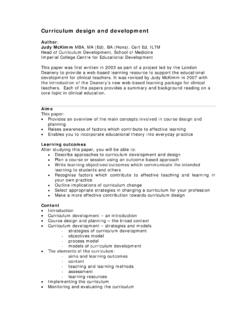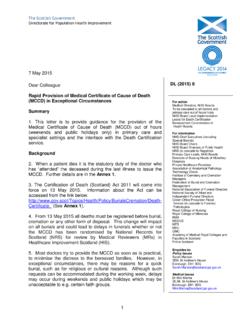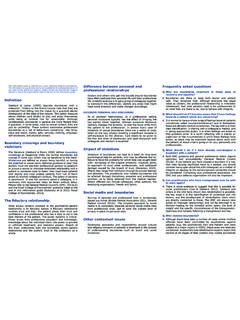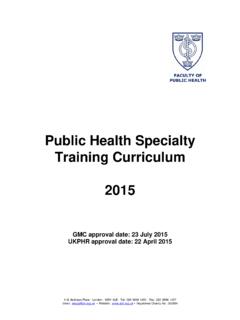Transcription of Facilitating learning: Teaching and learning methods
1 Facilitating learning : Teaching and learning methods Authors: Judy McKimm MBA, MA (Ed), BA (Hons), Cert Ed, FHEA Visiting Professor of Healthcare Education and Leadership, Bedfordshire & Hertfordshire Postgraduate Medical School, University of Bedfordshire Carol Jollie MBA, BA (Hons) Project Manager, Tanaka Business School, Imperial College London This paper was first written in 2003 as part of a project led by the London Deanery to provide a web-based learning resource to support the educational development of clinical teachers. It was revised by Judy McKimm in 2007 with the introduction of the Deanery s new web-based learning package for clinical teachers.
2 Each of the papers provides a summary and background reading on a core topic in clinical education. Aims The aims of this paper are to: Provide ideas of how to make the most of clinical situations when Teaching students or trainees Raise awareness of the advantages and disadvantages of a range of Teaching and learning methods in clinical Teaching Enable you to identify aspects of your everyday work which can be used as evidence for CPD learning outcomes After studying this paper, you will be able to: Identify opportunities for Teaching and enabling learning in everyday clinical practice Apply some of the major theories of learning and Teaching from Higher Education and healthcare contexts to your own Teaching practice Utilise a wider range of Teaching methods with students and trainees Develop a reflective approach to Teaching and learning which you can utilise in your own continuing professional development Contents Acknowledgements Introduction The changing NHS: what does this mean for teachers and learners?
3 The learning environment learner centredness The learning environment the physical environment Lifelong learning The adult learner Managing learning in a clinical and vocational context: o the education vs training debate o learning by doing becoming a professional o competency based learning o rehearsal, feedback and reflective practice Teaching and learning methods : o preparing for Teaching o Facilitating the integration of knowledge, skills and attitudes o Teaching and learning in groups o Facilitating learning and setting ground rules o explaining o group dynamics o managing the group o lectures o small group Teaching methods and discussion techniques o seminars and tutorials o computer based Teaching and learning information technology and the World Wide Web o introducing problem based learning o case based learning and clinical scenarios References, further reading and useful links Please note that the references.
4 Further reading and useful links for each of the sections are all in this section, grouped under subheadings Acknowledgements Thanks must go to colleagues who have contributed towards the development of this paper, in particular Clare Morris, Undergraduate Medicine Training Coordinator at Imperial College London and Dr Frank Harrison, Senior Lecturer in Medical Education, Imperial College London. Introduction This paper has been developed alongside Teaching and learning in the clinical context: Theory and practice and Integrating Teaching and learning into clinical practice. Between them, the three papers provide a comprehensive overview of Teaching and learning in the clinical context.
5 Theory and practice provides an overview of some educational theories, explains how these have impacted on Teaching practice and offers ideas for putting theory into practice in the clinical context with a view to creating good situations for learning . Facilitating learning : Teaching and learning methods focuses on the tools of the trade : looking at some of the main Teaching and learning methods that clinical teachers might use. Integrating Teaching and learning into clinical practice has been written to follow and extend the theoretical learning in the other two papers. It considers the challenges of Teaching in opportunistic settings and looks at ways to integrate Teaching commitments and learning activities into typical day-to-day clinical scenarios.
6 The changing NHS: what does this mean for teachers and learners? In the Theory and Practice paper you looked at some of key learning theories and how these might be used in clinical Teaching . There have been some huge shifts in recent years in the NHS and Higher Education which have changed the cultures of both. Without going into long sociological explanations, it is useful just to think of some of the key changes and look at how these have impacted on the role of and expectations from clinical teachers. Since the late 1990s, when national initiatives to reform undergraduate and postgraduate medical education were introduced, medical education (which includes clinical training) has gradually placed greater expectations and more responsibilities on clinical teachers.
7 The Department of Health initiative UMCISS (Undergraduate Medical Curriculum Implementation Support Scheme) which supported the reform of all undergraduate curricula in response to Tomorrow s Doctors (GMC, 1993) had a huge impact on undergraduate medical education. New Teaching and learning methods were introduced into courses such as problem based learning , video Teaching and web based learning and the courses themselves became less informal and more structured in terms of design, delivery and evaluation. Courses were expected to clearly define aims and learning outcomes, modes of delivery and assessment and the national agencies responsible for monitoring educational quality, the Quality Assurance Agency (QAA) and for medicine, the GMC, were looking in detail at how education was being provided.
8 See Evaluating Teaching and learning for more information about educational quality and course evaluation. The drive for change and improvement was not only limited to undergraduate courses, structured specialist training was introduced into the UK in 1996 and alongside this came some fundamental changes in postgraduate medical education. The duration of specialist courses were defined and curricula were set for each specialty which aimed to ensure that the standards recommended by the Royal Colleges were recognised by the STA (Specialist Training Authority). The Calman changes were concerned with: C urriculum A ppraisal L ength of training M anagement of training A ssessment N ational standards Such initiatives were also paralleled with changes concerned with modernisation of the NHS as a whole, the emphasis on patient-centred care, (The NHS Plan: A plan for investment, A plan for reform, DoH, 2000), at encouraging staff to work together more closely and learn in multiprofessional settings (eg.)
9 In Working Together learning Together: A Framework for Lifelong learning for the NHS. DoH, 2001), looking at how professions might be redefined in terms of their skills bases, areas of responsibility and competence (eg in A Health Service of all the talents: Developing the NHS Workforce. Consultation Document on the Review of Workforce Planning. DoH, 2001). One of the changes we are seeing in medical practice is less reliance on a particular individual s knowledge base or skill but rather on a team approach ..which includes representatives of all health Doctors must be prepared to teach and learn, not only within their own profession, but also across disciplines (Peyton, 1998).
10 The paper Multiprofessional learning : making the most of opportunities looks specifically at how to make the most of opportunities to introduce multiprofessional learning . Some European Union directives also impact on education and training such as the recommendations on vocational and postgraduate training and specialisation and the European Working Time Directive. Other changes include the impact of introducing technological innovations (particularly information technology, IT) into the workplace and the educational environment. We will look at some of the ways you can use IT and videos in Teaching and learning situations later in this paper.









